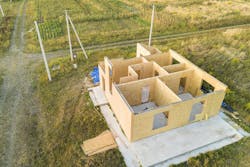Builders' Changing Views of Off-Site Construction Technologies
Many home builders searching for solutions to address ongoing industry challenges see off-site construction technologies as an answer, according to data from Home Innovation Research Labs. In August 2019, September 2020, and July 2021, Home Innovation asked builders how often they anticipate using certain off-site construction practices in five years compared to the past year. The most recent July results show builders are ready to adopt these practices and the pandemic accelerated their interest. Of the 348 builders surveyed in July, 22% said they would increase their use of roof trusses, 19% plan to increase their use of turn-key framing services, and 14% would use pre-cut framing packages more.
The July 2021 survey found that builder intention to increase roof truss usage continues at the top – signaling to truss manufacturers that now may be a great time to expand capacity to meet an anticipated increase in demand. Interest in turn-key framing services rose to the #2 spot in our 2021 survey, undoubtedly a beneficiary of the instability in the supply chain and the construction labor shortage. Interest in pre-cut framing packages and wall panelization followed in the #3 and #4 positions – slightly down from last year in intent-to-adopt, but still up considerably from 2019.
In terms of accelerating interest, turnkey framing, while not necessarily confined to offsite production, seemed to get the biggest boost in the past year. This was followed by precast concrete panels – not so shocking considering the relative stability concrete prices compared to lumber and wood panels. Modular building also saw an increase in interest since last year despite showing a market share decline over the past decade among new single-family homes our Builder Practices Reports and the U.S. Census Characteristics of New Housing data.
For offsite housing solutions to take deeper root, as these studies suggest they can, there must be additional production capacity built to meet and exceed the growth rate of U.S. housing production.
